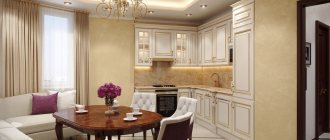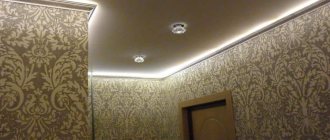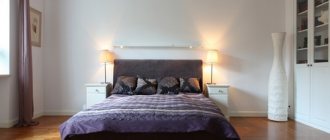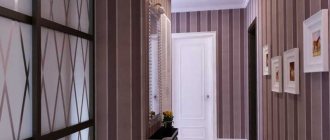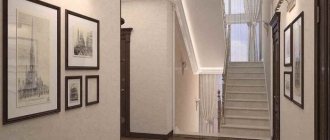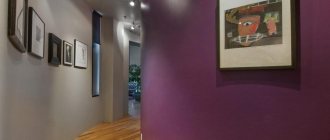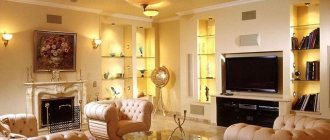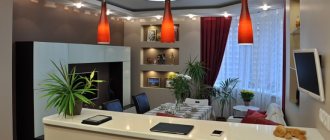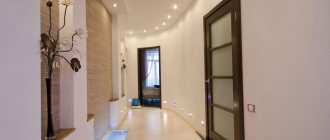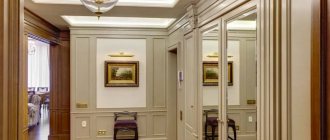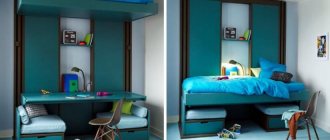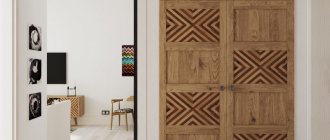The first impression of a house is formed from the threshold, which is why the appearance of the corridor is so important. In addition to the stylish and cozy decoration, it is necessary to think about the lighting of the ceiling in the hallway. After all, not only the perception of the apartment by guests, but also the convenience of getting ready in the morning depends on how well it is organized. Let us consider in detail the existing types of lighting fixtures, options for their location, as well as the possibilities of zoning and adjusting space with the help of light.
Which chandelier to choose for the corridor
Depending on the type of design, chandeliers can be suspended or overhead (or ceiling-mounted). The first ones are elongated in the vertical direction and due to this they “eat up” the height of the ceiling. As a rule, a hook is used for fastening.
Such chandeliers can be quite massive, with several arms, decorative inserts, etc. Such options are appropriate only in large halls. Pendant lamps of a more modest size are suitable for a high, spacious hallway, which are more often found in private homes than in standard apartments.
Overhead chandeliers have a small height, mainly occupying horizontal space. They are suitable for low rooms and are mounted on a bar.
When choosing the type of construction, it is necessary to take into account the distance from the bottom edge of the lampshades to the floor. It will be comfortable to walk along the corridor if it is about 2.2-2.3 meters.
Chandeliers also differ in the level of illumination, which depends on the number of horns, the type of bulbs and their power. The number of shades may vary. For a corridor, 2-3 are usually enough. It is better when the light source is closed so that it does not hit the eyes. If the horns are pointing down, you should choose frosted light bulbs.
The overall level of illumination should be sufficient to clearly see your reflection in the mirror, but not blind your eyes, this is harmful to your vision.
The level of illumination is measured in lux - lumens (unit of luminous flux) per square meter. According to SNiPs, the minimum value for corridors and hallways is 50 Lux. But it is desirable that there is not a big contrast with the rooms that are nearby. Information on the level of illumination and lamp power, as well as recommendations on the volume of the room, can be read on the packaging of the chandelier.
By type of light bulb they are divided into:
- incandescent lamps (the traditional version, they get very hot, which is why they use no more than 60 W with a suspended ceiling);
- halogen (here the limitation is even stricter - 35-40 W);
- energy-saving (consume a lot of energy when turned on and do not immediately flare up, therefore they are effective only with constant operation);
- LED (the most economical option, which is most often used with suspended ceilings).
The style and color of the device is selected to match the interior of the hallway. The designs and materials are varied. They use chrome-plated and brushed metals, glass, crystal, plastic, fabric, etc.
Classic style
A collected, cozy, classic-style hallway that creates a warm atmosphere will never lose its relevance. But this design option can also be diluted with interesting ideas. For example, use a pendant lamp.
Pendant lamp in the hallway interior
A classic hallway gains solidity and self-confidence thanks to the selected furniture. It is recommended to give preference to calm, light tones.
Selected furniture in light colors
An invariable element of a classic hallway is a massive wardrobe with a display case and a light, stylish small sofa.
Classic with wardrobe and small sofa
When placing furniture, the possibility of symmetry should be taken into account. Each element should be built in a single compositional center. So, for example, if a door acts as an accent, then the furniture should be built around it. It must be remembered that classics are characterized by the absence of clutter.
No clutter in the classics
Classic style, as a rule, is the personification of luxury and prosperity. That is why only expensive, high-quality materials should be chosen for interior decoration. Elegant accessories, luxurious mirrors, and forged parts are suitable as decoration. Floral patterns are appropriate.
Luxurious mirrors and elegant accessories
Classicism does not accept the use of large colors and geometric images.
Parquet flooring in perfect combination with all style
Ideally, the floor should be parquet, made of expensive wood species.
Spotlights and spotlights in the hallway
Spotlights are used both in addition to the chandelier and separately. By variety they are divided into:
- built-in (the housing is located behind a suspended or suspended ceiling);
- overhead (located on the surface, due to which they have a larger lighting angle).
Spots, unlike lamps, are equipped with a rotating mechanism. To change the angle of inclination, a hinge hidden in the body or a tire is used. Thanks to this, it becomes possible to direct the light flux to a specific point. Spots can be single or combined into groups - on a common platform or cable.
An important feature of dot products is their narrow focus. When used as main lighting, you need to install several devices at a short distance from each other (0.5-1 meter). In the corridor they are placed along a line, flat or wavy. For a square-shaped hallway, installation in the center and in the corners or along the perimeter is suitable.
Another option that can replace a chandelier is several spots united by a common base. An elongated shape is suitable for a long corridor, and a round shape is suitable for a hallway resembling a square.
When combined with a chandelier, the lamps are placed in areas that require additional lighting. This is a mirror, a wardrobe, a clothes hanger, a shelf for small items, etc.
Recommendations for luminaire placement patterns
How to correctly position light sources so that hallway lighting is as effective as possible? The original route of the electrical wiring, its condition, as well as your ability to design new routes for laying the electrical cable will be important.
- Central or main lighting. The lamp is located in the geometric center of the hallway - this is the point at the intersection of the ceiling diagonals. In this position, the lighting intensity is most advantageous. Additional light sources are located around the perimeter, along the walls.
- If the corridor is elongated and narrow, then it is worth placing several ceiling lights along the larger central axis.
- Wall lamps and sconces are mounted along the wall at a level of 1.8-2 meters. They should be slightly above eye level so as not to dazzle, but not too high, otherwise specific shadows will fall on the face, preventing you from adequately assessing your appearance.
- Local lighting: designed to illuminate specific areas. For example, the perimeter of a mirror, a poster on the wall, closet shelves. High-quality local lighting allows you to solve the problem without using the main light.
- Decorative LED lighting: this includes LED strips that can be used to illuminate the ceiling, baseboards, and doorways. Also now used for decorative lighting of rooms are garlands and LED grids, which are mounted on the wall as a light panel.
Manufacturers offer a wide range of lamps in various styles. When choosing, it is important to consider the height of the ceiling and the total intensity of lighting that you really need.
How to use lighting to expand a narrow corridor
There are several options here. The first involves the use of spots. They are directed towards the walls, thus visually increasing the space between them.
The second option is to build in lamps and arrange them not in a straight line, but in an arc. This technique visually expands the ceiling surface. These methods can be combined with each other.
Another method is to divide the corridor into zones, each of which is illuminated separately. Depending on the length, 2-3 sections are obtained. For example, space near the door for storing things (in the closet area) and moving things around. In this case, similar small chandeliers or spotlights are used.
Loft style
The 2022 hallway in the “attic” style will be especially relevant. For its arrangement, it is recommended to use fashionable textured panels that imitate brickwork.
Don’t go overboard and use a similar finish on all walls.
It is enough to veneer only one “like a brick”, and simply paint the rest in a light color.
For a loft hallway you need to use built-in furniture and a couple of designer items in an industrial style.
For example, it could be real paint or an ottoman with an aluminum base for a large fan.
Custom lighting ideas
In addition to the usual lighting devices, original solutions are available with suspended ceilings that will add a “zest” to any interior. Let's consider universal options, suitable for both spacious and small spaces.
floating ceiling
It features LED lighting around the perimeter. But the design is made in such a way that it seems as if the ceiling does not touch the walls and seems to be floating in the air. Most often used as additional lighting, but in a small hallway it can also serve as the main source of light.
To create a ceiling effect, the tension fabric is mounted using a special profile. It differs from the usual one in that it leaves a small distance between the walls and the ceiling, and also has space for installing an LED strip. The profile is attached around the perimeter of the room, then the PVC film is stretched and the LED strip is laid. After turning on the backlight, you get the feeling that the ceiling is not connected to the walls, but is floating above them. This technique not only looks original, but also increases height.
Read more: How to make a floating stretch ceiling with lighting
Important! The diode strip must be looped. Otherwise, the brightness will decrease as you move away from the power source.
Glowing ceiling
This option is a hidden backlight installed behind a translucent sheet. When the light is turned on, the ceiling resembles a large lamp and is often used as the main lighting.
Installation is a little more complicated. First you need to get a flat floor surface. It is leveled and, for better reflection, painted white or covered with foil. Then the lighting is installed. Diodes are most often used - in the form of strips or panels. A translucent film is mounted below, which scatters the rays. The result is a surface that emits an even glow, quite bright, but comfortable for the eyes. When the lights are turned off, the coating looks like a regular stretch ceiling.
Note! With this option, the ceiling height is reduced more. But this is partly compensated for by the visual effect.
Light lines and patterns
In this case, a translucent fabric and diodes are also used. But the tape is placed in special baguettes that cut off the light on the sides and direct it down. The technologies are a little different.
In the case of lines, take a more powerful tape or lay it in two rows. The profile above it is covered with a scattering layer, and the rest of the space is covered with ordinary film. When turned off, the difference is almost unnoticeable. And when turned on, the strip provides enough light.
The lines can be located along the walls or diagonally, parallel or intersecting. In a long corridor, it is better to install them across - this will give the effect of expanding the space.
The patterns are made using similar technology. But baguettes can be bent into the most bizarre shapes, creating designs and even inscriptions. Sometimes LED strips are attached in the form of patterns and cover the entire surface with a translucent sheet. This decor will decorate the interior and highlight a certain area. Additionally, it is possible to install spotlights that will fit into the picture and create a single composition.
Peculiarities! The pattern can be made colorful and even changing tone. To do this, lay down an RGB tape, and the color changes using the control panel.
World of lamps
For apartment hallways and corridors, you can use the following types of lighting fixtures:
Ceiling and spotlights are a common technique.
- Spot and ceiling lamps. This solution is universal. It is perfect for a tiny hallway in a Khrushchev apartment and for a huge hall in your own house.
An example of a lamp with a rotating shade.
It is convenient when the selected lamps have the option of adjusting the shade. Such devices can be placed both along the wall and on the ceiling.
The chandelier is good for a spacious room.
- The traditional lamp in the hallway is a ceiling chandelier. This solution will not be the best if the room is very small. The best option for using a ceiling chandelier is in a hallway that has a significant area and correct geometry.
Wall lamps are optimal as local light sources.
In all cases, a ceiling lamp in the form of a chandelier can be complemented by sconces as local light sources.
- Wall “luminaries” are not able to fully recreate high-quality lighting. However, they generate the diffused light necessary in the hallway.
Accent the picture with the help of sconces.
Sconces are also optimal in cases where you need to focus attention using lighting on some decorative element of the interior.
LED lighting around the perimeter.
- LED lamps in the form of spotlights or strips have become very popular in recent years. They are very economical in terms of energy costs and are varied in reproducible light colors and designs. Although LEDs are convenient to use, their spectral glow is not always comfortable for our eyes.
Most often, spotlights are used for local lighting.
Local lighting is most often provided using various models of built-in spotlights. They are not only functional, but can also be very original in design.
Practical recommendations
Original lighting around the perimeter of the floor.
- Use decorative lighting more actively. Moreover, it can be installed not only on the ceiling or walls, but also along the perimeter of the floor. This way you can recreate the original decorative effects and remove the feeling of enclosed space.
Glazed doors will allow natural light to penetrate into the hallway.
- The instructions recommend choosing interior doors opening into the hallway with glass elements on the leaves. This will make it possible to saturate the room with natural light coming from other rooms.
This is how a light with a motion sensor works.
- Take a closer look at lighting fixtures equipped with motion sensors. Such lamps are practical and easy to use. They make it possible to significantly save electrical energy without requiring your personal participation. At the moment, the price of such products has become quite acceptable for all categories of users. You can install such a lamp yourself.
Paintings are an interesting design move.
- For long rooms, an excellent technique that will diversify the monotony of the walls will be objects of artistic or applied art. They can be illuminated with turned instruments. Bare walls, for example, can be turned into a kind of exhibition for crafts and products made by you and your family members.
Let there be light!
- Protrusions or niches in the room also need lighting. To arrange it, it will be quite enough to install a spotlight on the top of the structural element.
When purchasing products for corridor lighting, pay close attention to their color. The most comfortable and pleasing to the eye are lamps and LEDs that are yellow in color. Cool white lighting makes the room look uninhabited. Red irritates the eyes, and blue can put pressure on the psyche.
My light is a mirror...
Good mirror lighting – beautiful reflection!
The mirror, especially when it is large or life-size, must be illuminated as well as possible.
And you will have the opportunity to see a neat and smiling face in the reflection.
Makeup also requires high-quality lighting.
- The optimal solution has always been considered to place sconces on both sides of the mirror on the wall.
Traditional arrangement of wall lamps near the mirror.
But design technologies do not stand still. Now manufacturers produce a lot of mirror models that have built-in lighting in the form of spotlights.
But it is better to light the mirror from above.
- Lighting fixtures for mirrors should not only be aesthetic, but functional and practical. The best solution here is a lamp with a laconic shape and a light matte shade. It will provide the space with diffused and soft light that does not strain the eyes.
Lamp on a flexible bracket.
- An excellent choice would be lamps with a rotating shade or located on a flexible bracket.
Keep in mind that the lamps located near the mirror are a local light source. They cannot replace general lighting.
Lighting schemes
In a square or similar hallway, a chandelier is placed in the center. With a suspended ceiling in the corridor, additional lighting will be provided by spots. They can be positioned symmetrically relative to the middle:
- in the corners;
- along one or two parallel walls;
- along the perimeter;
- along a circle or ellipse.
The second placement option is to highlight significant objects: a mirror, a closet with clothes, a bench or a chair for putting on shoes. If paintings, vases or other works of art are placed in the hallway, accent rays are directed at them. This method not only provides a variety of lighting, but also divides the space into functional zones.
For a rectangular room, an elongated chandelier is suitable, or even better, a tire with spots. As in the previous version, the circuit is supplemented with small devices in the right places.
For a long corridor, two or three small chandeliers are a good choice. The lighting will become more uniform. This arrangement is another way of dividing space. Each lamp designates and emphasizes its own zone.
If only built-in lamps are used, you need to take a sufficient number (approximately one per square meter). They are distributed more or less evenly, in a long corridor - along a straight, elongated arc or wavy line, in a more compact room - in a checkerboard pattern, in a grid, in circles, etc. For Khrushchev, a spot in the center and in the corners will be enough.
Peculiarities! Switches with a motion sensor are convenient in hallways. If you install this, you won’t have to look for the button in the dark. And in elongated spaces, pass-through switches (on each side) are useful.
Hallway lighting with plasterboard ceiling
For such ceilings in the hallway, any lighting options are appropriate. However, pendant lamps and chandeliers must be mounted under a metal profile or a special dowel.
Due to their characteristics, plasterboard ceilings practically do not reflect rays. But you can create spectacular hidden lighting for the corridor by placing shelves with lighting fixtures in the lower box of the structure. You will get stunning light lines with soft, unobtrusive radiation. It is not necessary to make them even - if there are decorative elements on the ceiling, the stripes can follow their contour. The photo shows a vivid example of the implementation of such a lighting project.
Lighting a plasterboard ceiling in a hallway
Additional wall lighting
This element is not necessary, but with its skillful use the hallway becomes more beautiful and cozy. Light bulbs on the walls will complement the ceiling lighting.
Sconces are often hung on the sides of the mirror. This way the face is illuminated more evenly, without shadows from below.
If there is a shelf for small items or a hanging key holder, it is useful to highlight it too. Lighting for paintings and photographs can also be placed on the wall, but it is better from above, directing the light beam downwards. A spot or small narrow LED lamp will do.
Light wardrobe in the hallway
Practical hallway cabinets should be designed to make daily life easier
It is important that they are roomy, aesthetic and fit well with the interior, since a hallway wardrobe is the first element of decor that guests will see when they cross the threshold of the house
Light cabinets for the hallway - arrangement of a small space
Hallway closets are designed to help store clothes, but they also need to work well with a space that is often difficult to organize. Often in apartments there is a small, poorly lit corridor in which there is not enough space for everything. In such a situation, choose light-colored cabinets, as well as a model with a mirror, which will visually expand the space of the room.
Characteristic of a bright hallway interior is, first of all, an emphasis on space. When taking any organizational step, you must keep this in mind. So, how to decorate your hallway to give it a beautiful appearance using light colors? Take advantage of ready-made ideas in the photo gallery.
Examples of interior lighting
Depending on the size and shape, different lighting options are suitable for the hallway. This could be a chandelier, a system of spots or a soaring ceiling. And for accent lighting, built-in appliances or wall sconces are suitable.
DIY LED lighting for stretch ceilings
The lighting will be located under a translucent stretch ceiling. The first level is a suspended ceiling, the second lower level is plasterboard. When you plan to make LED lighting under a suspended ceiling, you need to meet strict requirements for surface preparation.
- First, a membrane or suspended ceiling is stretched, then an LED strip is attached around the perimeter and then the main matte translucent suspended ceiling is installed;
- When installing a stretch ceiling, a strip is attached to the wall, to which it is then attached;
- Any LED strip consists of LEDs that emit heat and consume energy. LEDs need cooling. Use aluminum strip, profile. For ease of installation, an aluminum strip is used, and an LED strip is glued to it. The heat dissipation is sufficient for operating LEDs;
- An LED strip with an aluminum profile is fixed so that the LEDs are level with the mounting strip.
To secure the tape, we will need a laser level, a tape measure or square, glue, a glue gun, and a soldering iron.
If you don’t have a laser level, you can get by with a ruler or square.
1 Step
We place the mounting profile for the main stretch translucent ceiling at a distance of approximately 2 cm from the edge of the 2nd level plane. We will use the same profile to fasten the aluminum strip. A mounting profile is attached along the perimeter of the shelf using self-tapping screws or glue. Use a square with a ruler extending to mark a distance of 5 cm from the edge of the plane.
2 Step
We will attach the mounting profile for the LED strip with an aluminum strip to liquid nails using a gun. Drill holes on it every 500 mm with a 4 mm drill
It is very important that the strip is glued smoothly without corners or protrusions. Burrs from the resulting holes can be easily removed with a larger diameter drill. 3 Step
3 Step
Let's coat the back side of the profile with glue and install self-tapping screws for convenience. Let's place the profile to the wall according to the previously made marks and temporarily screw it to the drywall with self-tapping screws. When the glue dries, the screws are unscrewed and the profile is held rigidly, securely and evenly. We will glue the aluminum strip with mounting adhesive, aligning it along the lower edge of the mounting strip.
4 Step
LED strip is sold in reels 5 meters long. If you need more footage, then buy another piece of tape. Two sections of the LED strip are connected to each other using a special connector for them. We thread the tape into the connector and clamp it. The downside of this connection will be that the contact is not reliable enough; in unpleasant situations, the suspended ceiling will need to be removed.
To connect 2-3 sections of the LED strip, use a special four-core cable and a soldering iron. If you mount the tape in places accessible for maintenance, then it is more convenient to use connecting elements.
When purchasing tape in a store, you need to select a power supply of appropriate power.
5 Step
A cable of 4 cores is soldered to the RGB strip
It is very important to observe the color designation of the four-core cable. The tape has the designations B-blue, R-red, G-green and the last pitcher is black. We strip the wires and process them with a soldering iron
We strip the wires and process them with a soldering iron
When soldering, pay attention to the solder, it should not overlap adjacent contacts
6 Step
Before attaching the tape to the aluminum strip, you need to check that everything works. Remove the silicone tape from the tape and press the tape in small sections. We perform this action along the entire perimeter of the room.
The installation of the LED strip for the ceiling is complete.
The hallway is the main part of the house
It is very important not to overdo the lighting here and not make it too dim. Don’t get tired of choosing wall sconces, chandeliers, spotlights. Let everything correspond to a single style and fit harmoniously into the interior
Light up pictures, mirrors, cabinets and all other important elements. Create a mysterious hallway or fairytale tunnel
Let everything correspond to a single style and fit harmoniously into the interior. Light up pictures, mirrors, cabinets and all other important elements. Create a mysterious hallway or fairytale tunnel.
Glossy
This word is usually used to designate surfaces with maximum light reflectance. This material gives an almost mirror effect, visually “doubling” the volume of the corridor.
Transforms the room and visually expands its boundaries.
Tensile structures in “gloss” look harmonious in a single color scheme, for example, a beige, sand or light brown room.
The glossy surface creates unusual highlights and adds a little luxury and glamor to the corridor.
In a small “patch” at the front door, where several corridors lead, the principle of zoning is often used, thanks to the combination of panels.
They reflect light well and make the corridor brighter.
Attention! In narrow hallways and foyers, gloss will only increase disproportions, visually “narrowing” the walls. If the geometry of the space is complex, the best solution is a glossy ceiling in the hallway, matte or satin in the adjacent aisles
With low ceilings in a rectangular hallway, gloss may be the only right solution, as in the example in the photo.
Using glossy coatings in light colors, it is easier to make the passages more spacious.
Light wallpaper in the hallway
The hallway should look especially aesthetically pleasing and welcoming. To decorate your walls, you can choose wallpaper with a special collection of patterns and high durability. This is also the room where the walls are especially prone to getting dirty. Therefore, to ensure that your wallpaper will look good for many years to come, you should choose the highest quality product. Choose from a wide selection of unusual wallpapers that will amaze you not only with their fantastic design, but also with the richness of textures and high quality of the materials from which they are made. Light-colored options would be an excellent choice.
Monotonous or multicolor? Classic or modern? With a plant motif or urban architecture? Choosing the right decorative wallpaper for a specific room can be a daunting task. Interior design with decorative wallpaper in light colors is back in fashion. The principle that should be followed when choosing decorative wallpaper for walls is, first of all, that it is in harmony with the entire interior and especially with the door and floor. You must not forget that the pattern of decorative wall wallpaper should also match the size of the room. Thus, the others will be wallpaper for the living room, kitchen or hallway. Therefore, when searching for wallpaper for walls, it is worth clarifying all the criteria that are important to you. It's best to start by choosing your favorite colors, considering the texture, which can be smooth or patterned.
Designer recommendations: playing with light
When choosing the color and texture of the hallway, you should not forget that one of the main positions in creating its design is occupied by lighting. With its help you can add an original accent, emphasize advantages or hide minor flaws.
Lamp shades will help add a touch of original individual style. They can change the color of the light itself, and therefore the shades of the room. It looks very impressive. How does the color of lighting affect perception, and what chandeliers are hung in the hallway of different sizes?
A long hallway can be decorated with several lamps.
- Red.
Does not allow you to relax, partially excites the nervous system.
If you stay under its influence for a long time, fatigue may occur.
A chandelier will give harmony to the interior, hide minor imperfections in the decor and help give the desired effect.
- Blue.
With short exposure it relaxes and calms.
Like blue, it promotes relaxation, but should not be chosen for very small rooms.
It is the most pleasing to the eye and does not tire.
To create a unique play of light, different types of materials are also used, which can reveal the design of the room in a new way. Let's look at the most popular ones.
Material and resulting effect.
- Crystal – shimmering light and faint shimmer.
- Relief glass - rainbow glow.
- Plastic with anti-glare effect - gentle velvet light.
- Fabric – soft lighting.
An original approach to creating colorful light and shadow solutions would be to use relief patterns on the walls and ceiling.
The hallway is the place from which one begins to get acquainted with the house. Its design influences a holistic opinion about the interior. Therefore, the correct choice of lighting is very important.
Form and style direction
For the corridor it is necessary to select accessories in light colors. This rule also applies to ceiling lamps. Snow-white models look beautiful. To make the corridor visually larger, you should decorate the walls in light colors.
Elongated models look beautiful in rectangular rooms. For a square hallway, you can choose a fashionable quadrangular or round model. The lamp looks beautiful if it matches the color of the room decoration.
If the hallway is presented in a minimalist style, then spotlights will look beautiful and stylish.
If the upholstery of the room contains wood, then the lamps can also be decorated with this material.
Lamps made of wood with square shades made of snow-white frosted glass are fashionable today. They will allow you to embody an oriental theme in the interior. For a corridor where bamboo and wood are used in the interior, you can use luxurious lamps with paper lampshades.
A chandelier in fusion style looks fashionable and impressive. It is represented by geometric shapes that surprise and fascinate with its exquisite brevity.
Technical points
The illumination in each room of the house is standardized by SNiP. According to his recommendations, in the hallway and corridor there should be 50 lumens of luminous flux per meter of area. In this case, everything is calculated simply: calculate the area of your room (if you have a wardrobe, don’t count it). You multiply the found figure by 50 lm, and you get the luminous flux that all lamps should produce.
For example, the hallway measures 2.5*1.8 m. We find its area by multiplying the numbers together: 2.5*1.8 = 4.5 m2. Next, we find the luminous flux according to the norm: 4.5 * 50 = 225 Lux. That is, all the light bulbs that we install in this corridor must provide illumination of at least 225 Lux. This is exactly the luminous flux (or more) that hallway lighting should have.
Hallway lighting must also comply with standards.
There is one more technical subtlety that will make life more convenient and enjoyable. Usually the light switch in the hallway is located near the door. If it is small, this state of affairs is quite tolerable - you can take a couple of steps even in a poorly lit space. This is very inconvenient in a long hallway or corridor. You turn off the lights and walk in the dark. During daylight hours it’s even more or less so, but in the evening or at night wandering around in the dark is not very pleasant. This situation can be corrected by installing pass-through switches that allow you to turn on and off the light from several points. For example, place one near the front door, the other near the door to the room and/or kitchen.
Connection principle for a pass-through switch
It is especially convenient to use walk-through switches in a long corridor. They turned on the light near the entrance, walked along the illuminated corridor, and turned it off near the room. And vice versa: they turned it on at the room, got dressed, went out, turned it off. It’s convenient, and besides, lighting the hallway will also be economical, since there is no need to leave the lamps on.
If there is a wardrobe or dressing room in the hallway, their lighting is done separately. There is even a standard for dressing rooms - 75 lm per square meter. It is better to use LED lamps as light sources - they emit the least heat and shine brightly.
There is another opportunity to save on lighting bills and not compromise on ease of use - install motion sensors. They will turn on the hallway lighting only if someone is in the room. The only difficulty may arise if the corridor has a curved shape: you will have to install two sensors and point them in different directions.
Lighting and interior solutions
The design of lighting fixtures should match the interior of the room.
- The popular and modern loft trend is characterized by laconic and uncomplicated forms. Lamps made in this manner do not have additional decorations or decorative elements. Aged lamps are suitable for such an interior. For loft-style ensembles, you should choose ceiling lighting made of plastic, glass or metal.
- Ceiling lamps in the high-tech and minimalist style should have the most simple and clear lines. They can be made from inexpensive industrial materials and have a discreet appearance. Also in these modern settings, a luminous ceiling can be used as main lighting.
- Today, such an airy style as Provence is at the peak of popularity. In such interiors, ceilings complemented by beams look harmonious. You can complete such settings with beautiful and elegant lamps with light shades of medium size.
- Lighting a room in the Art Nouveau style should have regular shapes and clever, bold and original configurations. In such interiors, devices containing elegant forged metal or custom lampshades will look harmonious.
- Large chandeliers with wrought iron and glass compositions look organic in classical ensembles. They can have elegant and luxurious shapes. However, such lighting fixtures are not suitable for low ceilings.
7 photos
Methods for choosing a chandelier
Chandeliers in the hallway should not be particularly pompous. Therefore, models of calm design are offered.
It is advisable to buy chandeliers for the hallway without dimmers and any decorations.
We also recommend:
Chandeliers for a small hallway are divided into two types:
- ceiling;
- wall-mounted
There is a method for installing an electric lighting fixture on the floor. This device is used as auxiliary lighting.
We also recommend:
Hanging four-arm chandeliers for the hallway
Nowadays, the lighting market can offer us a huge number of chandelier options. Wooden, metal, LED with and without remote control. But still, four-arm chandeliers do not cease to be popular in the electrical market.
Hanging four-arm chandeliers are chosen mainly for rooms with high ceilings. Such chandeliers are universal, they can be chosen to suit every taste. Thanks to the presence of arms, the chandelier is suitable for central lighting in a spacious hallway. The advantage of such chandeliers is their ease of installation. You can handle the assembly and connection yourself.
Carob chandeliers are easy to care for; you just need to remove the shade and wipe it with a damp cloth. Another advantage of horn lamps is that when changing the interior, you don’t need to buy a new chandelier. It is enough just to change the lampshades to match the new design.
